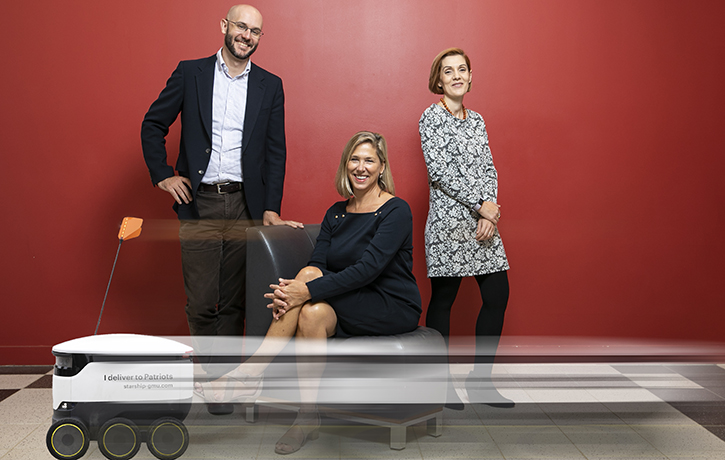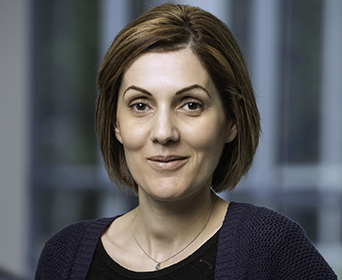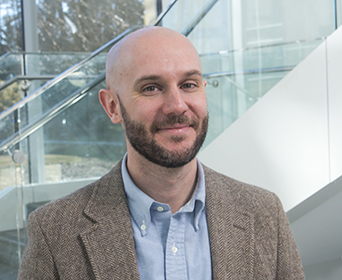
Mason researchers Dave Lattanzi, Brenda Bannan, and Amarda Shehu are leading the new Center for Advancing Human-Machine Partnership. Photo by Ron Aira/Creative Services/George Mason University.

Amarda Shehu, a professor of computer science, says the new Center for Advancing Human-Machine Partnership will conduct convergent research with experts from several disciplines uniting to look at problems in different ways.
Your smartphone reminds you to go to a meeting. Pop-up ads recommend items you might want to purchase. Chatbots converse with you about shopping.
Technology is woven into most people’s lives, and in the future, machines will be smarter and play an even bigger role in the workplace, education, and daily lives, says Mason Engineering’s Amarda Shehu, a professor of computer science.
There will be an increasing interconnectedness between computing systems and the people who use them, agrees Dave Lattanzi, an associate professor of civil engineering.
This interconnectedness will need to be transparent and interactive so people trust the systems they are working with, adds Brenda Bannan, an associate professor in the College of Education and Human Development.
To explore the best ways to navigate this new frontier, Shehu, Lattanzi, and Bannan are leading Mason’s new Center for Advancing Human-Machine Partnership (CAHMP).
The interdisciplinary team includes faculty members from six colleges, including the Volgenau School of Engineering, the College of Education and Human Development, the College of Humanities and Social Sciences, the College of Science, the College of Visual and Performing Arts, and the Schar School of Policy and Government.
The center is one of two new multidisciplinary centers announced recently by Mason Provost S. David Wu and Deborah Crawford, vice president for research, innovation and economic impact.
The purpose of CAHMP is to rethink human-machine partnerships and to design technology in a way that puts people in control, Shehu says.
Mason researchers will conduct convergent research with experts from several disciplines uniting to look at problems in different ways.
Computer scientists, psychologists, social scientists, human factors researchers, philosophers, policy experts, engineers, education researchers will tackle fundamental questions about how machines can operate in a contextual setting, adapting to the people who guide them while engendering trust, she says.

Dave Lattanzi, an associate professor in the Sid and Reva Dewberry Department of Civil, Environmental, and Infrastructure Engineering, says in the future people will be relying more on machines so they need to be able to trust them and communicate with them.
Faculty researchers with the center will:
- Conduct multidisciplinary research studies. Experts in learning science and disabilities might collaborate with engineers and information scientists to support people with disabilities in communication and navigation.
- Write policy papers. Experts from public policy and economics will think about how human-machine partnerships could affect the economy.
- Outline the best way to handle changing workplace dynamics. Experts from social science and psychology might explore how humans and machines will work together in teams.
- Create software to be shared with other researchers. Researchers might create a new artificial intelligence infrastructure design system to help civil engineers and architects sift through hundreds of thousands of designs for a structure.
- Train college students in a multidisciplinary research approach.
- Encourage high school students to consider technology degrees.
- Address questions about trust, ethics, and transparency in future human-machine partnerships.
Many people have social anxiety about relying on machines for decisions; they don’t understand and trust the systems that are being built, Lattanzi says.
“In my field, we have wonderful robots and artificial intelligence systems to help in civil infrastructure, but people don’t use them because they don’t trust them,” he says. “I get the response, ‘This is great, but I don’t trust it to do as well as a human does.’ In reality, it’s better than humans are. We over-trust humans but under-trust machines.”
In the future, people will need to be able to trust and communicate with machines. For instance, autonomous vehicles need to know where passengers want to go and understand their needs; passengers must be able to communicate back, he says.
Machines are going to get more intelligent, Shehu says “Right now, they aren’t very smart and are designed for specific tasks. A movie-recommendation system can only recommend movies. One direction where we want to go is general, integrated intelligence, such as … a personal assistant that helps you with your day-to-day decisions, your health, and more.”

Brenda Bannan, an associate professor in the Division of Learning Technologies in the College of Education and Human Development, says machines have to be designed with the user in mind.
Engineering researchers are designing more intelligent machines that adapt to personal preferences over time, she says. Those scientists will work with psychologists to design ethical and usable systems that can be trusted and can explain how they arrive at decisions.
The goal of human-centered design is to keep the user in mind throughout the process, Bannan says. “If we include potential users of the technology system in a co-design approach from the beginning and throughout, we have a much better chance to design interactive systems that are intuitive, trusted by users and protect their privacy.”
Shehu hopes CAHMP, which has funding for five years, will be recognized as a leader in human-machine partnerships. “We are preparing for a time when humans and machines work together side by side, and we want to lead in this space.”
